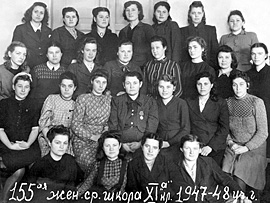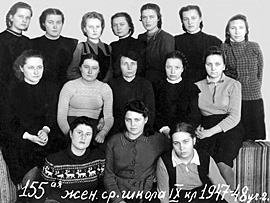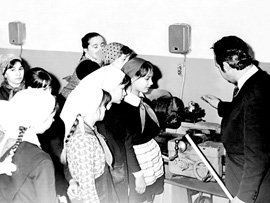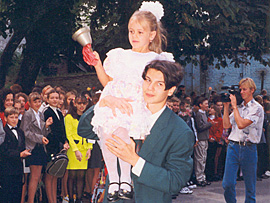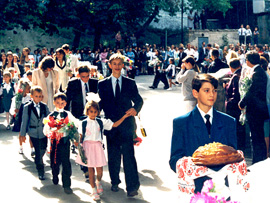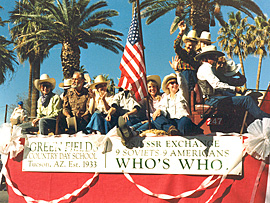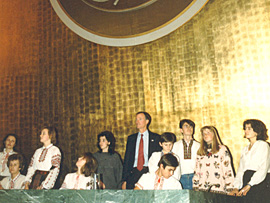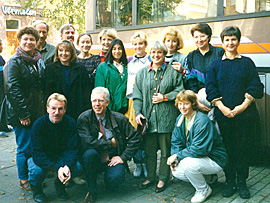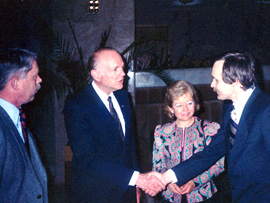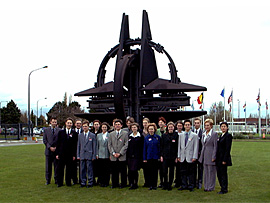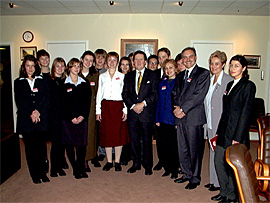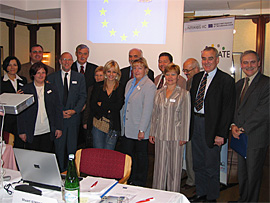|
ABOUT THE SCHOOL > HISTORY 155
Pages of history of Kyiv English Language school # 155 Comprehensive school # 155 was founded on September 1, 1936 by the decision of the Executive Committee of Kyiv City Council of Workers Deputies I Molotovsky district. Russian was the language of teaching at that time. French was studied as a foreign language. The school was located in Voroshylov street 26 (Jaroslaviv Val street now) for the first year of its functioning. " In October 1937 school # 155 was moved to a new building. The school is located in that building till now. Old timers say that our school was built on the spot, where an old church used to be. The first principal of the school was Rebecca Kotlyar. During the second world occupation, for several months in 1941/1942 they allowed the students of 1 - 4 grades to study. Peculiar fact is that they took the textbooks of German language from the students away. When winter came the studying at school was stopped. Soon the headquarters of Nazi punitive force regiment was accommodated in the school building. The occupants destroyed school library. School furniture was burned for heating. Nearly all pre-war graduates went to fight at the front. Many girls served as nurses in the Rd Army. Many students perished in Baby Yar. At night 6/7 November 1943 Kyiv was liberated from the Fascist occupants. And on Students together with teachers were putting everything back in order in the school classrooms. They were bringing coal from Podyl on their sledges to heat the school. The students regularly assisted the wounded Red Army soldiers in the maxillofacial hospital in the Pokrovsky monastery. Students of 6-10th grades of that time recollect that they worked for 10 days every month of a school year to clear the ruins in Kreschatyk street and stubbed the tree roots of the burned trees on The first post-war school director was Lazar Turenko. Then, from November 28, 1943 till 1946 the school director was the teacher of Ukrainian language and literature Hanna Hryschenko. From 1943 till 1958 School # 155 was for girls only.
Since that time teaching at the school is conducted in Ukrainian language. 10th and 11th grades were the graduate ones. Girls – graduates of the 11th class were awarded qualification of the elementary school teachers. The school operated in two shifts (day school and evening classes). There were a lot of overage juveniles at the school. They were the students, who were not getting education during the war time. The number of such students grew, when boys from school # 55 were moved to Sch. 155. Overage juveniles were studying at Sch. 155 till 1960. From 1946 till 1947 Oleksandra Kravchenko was the director of Sch. From 1947 till 1959 Julia Loshakivna, a teacher of chemistry was the school director. The 11-minute documentary film about school # 155 “At a school” was shot under the guidance of the poet Valentyn Bychko. In the 50-s vocational training was introduced at our school, just as in all other schools. Students of the 9–10th grades were trained to get qualifications of radio-operators and electro-mechanic. From the middle of the 50-s the epoch of summer labor camps begins in all schools It lasts till the middle of the 80-s. The students of the 7-9-th grades worked at the sovkhoses (state farms) and kolhoses during the Summer time. In the 60-s the seniors were getting their qualification in the profession of the telephone and telegraph operators. In 1958 the school was given the status of specialized school with the in-depth study of English language. At the same year the oven heating was changes for central steam heating. Since 1959 till 1970 Halyna Habrys, the teacher of Russian language and literature was the principal of Sch. 155. In the 70-s the school had two prominent features. The first – the school has a high level of recognition of its educational and bringing up level. A number of subjects were taught in English. The second – number of enrolled students was one of the lowest (only 300). In the 80-s the first floor of the school was occupied by the musical school # 8. Though all Universities were teaching in Russian, school # 155 continued teaching in Ukrainian. Authorities even wanted to close the school… From 1970 till 1974 teacher of mathematics Natalya Lazorenko was the school director. From 1974 till 1986 – teacher of English language Valentyna Bozshok. 1986, the year of Chernobyl Disaster was the year of the school 50th anniversary. The students of the 1-7th classes were evacuated to the pioneer camps in Skadovsk in Since In 1987 Sch. 155 begins intensive work to implement international programs, development of students self administration. International educational approaches in education are being adapted to the Sch. 155 practice. In the 90-s the basis for the systematic computerization and foundation of monitoring process of the quality in education. Implementation of IT into the system of quality management has become an outstanding feature of the decade. In 1993 the first testing of students’ knowledge was conducted with the help of audio-technology. In four years the seniors sat for the video-testing for the first time. That type of testing is known as "directors’ tests" now. In February 1995 Sch. 155 conducts the first all-school scientific and research students’ conference. In 1995 for the first time in In the same year the system of automated test generation was introduced at the school. That cleared the way for the transparency and integrity of students’ performance evaluation. The ideas and practice of "independent testing" at Sch. 155 were presented to International Renaissance Foundation as a model for the implementation at the national level. That was the beginning of the current Independent Testing in In the end of the 80-s, and at the beginning of the 90-s implementing "perestroika" ideas, Sch. 155 makes its first unprecedented break through the Iron Curtain into the World. Hundreds of Sch.155 established friendly contacts with American peers thanks to the project "Birthday Pen-Pals", initiated by American friends and teachers of Sch. 155. Many of Sch. 155 graduates remember ice-cream they were making with their peers- American children – leaders of the "Giraffe" project – those who always stick their heads higher than others. Sch. 155 invites American policemen from In 1989 Sch. 155 and Green Fields Country Day School, Tucson, Arizona, USA (principal Phineas Anderson) have conducted the first unprecedented students’ and teachers’ exchange. The exchange was done by the individual initiative of the two principals and was not a part of any government program. The principals were not seeking any kind of approval from 1989 – Sch. 155 students are the first official guests at the United Nations Organization and in the Congress of the Exchange programs expand to the The end of the XX cent., beginning of the XXI century are marked by the active search of the best international educational practices. The Sch. 155 international activity attracts attention of prominent international leaders. Director of the Office of the US State Department Bob Persico visits the school in 1991. Regional Director for Central and Eastern Europe of International Baccalaureate Organization Monica Flodman visits Sch. 155. General Secretary of NATO Lord George Robertson visits the school in 2000. 2002 – General Secretary of NATO Lord George Robertson invites Sch. 155 students to visit NATO headquarters in 2000 – Sch. 155 enrolls the six ear old children to first grade. This process goes in line with the all-state state program of the school transformation. The place for the six-year school children is provided in the daycare centre in Kurdryavska street. 2000 – Students of our school get their first unique record transcripts, printed out on the basis of the IT processing. In October 2001 the school Media centre is open. Right in the centre of the school building Media centre becomes the place to concentrate reference material and communication facilities for the students. Strengthening of teachers-parents cooperation becomes one of the central themes for those years. A new form of parents-teachers’ cooperation is evolving and growing – the task force groups of parents are forming the database of students’ records, thus working hand in hand with teachers in the process of students academic results evaluation. Parents’ association becomes a decisive factor in school life. To strengthen family values Sch. 155 lays the background for new traditions. Family Days become traditional days of the child’s pride of her or his family – family history, family relicts, family great love story. Since then parents are invited into the classrooms to share their live experience with all students in the classrooms. The first decade of beginning of the XXI cent is marked by the search of the Sch. 155 students’ identity. Since 2004 School Days in November become a regular milestone for every class and many students to evaluate the achieved success and plan future progress. All that is done on a big stage of the House of Artists in the form of artistic presentation. New activities, like Crazy Hair Day, Toy Day, are added to the traditional Flower festivals, Annual Science Fair, Mr. School etc. In 2005 by the initiative of the Ministry of Education of Ukraine Sch.155 begins its work in the European Union project EdGATE. The objective – to design the model for a network of the schools for future The great event of 2007 was launching of Sch. 155 school website. In 2008 every student gets her/his e-mail address. Computers are put in every elementary school classroom. Elementary school students must now send information about their home assignments to their peers who are not at school. 2007 – 2008 Sch. 155 are the years of probing a new cross-border ways of teaching, chemistry in English together with the partner, Friedrich Ebert Gymnasium, 2008 – for the first time in the history of secondary education in |
|
© 2007 - English Language School # 155 - Kyiv, Shevchenkivsky District, Artema Str. 5 - Tel.: 272 08 26



